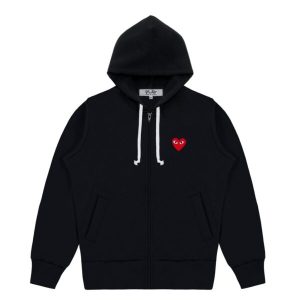In the world of fashion, where trends are commedesgarconco.com/ ephemeral and aesthetics often follow predictable patterns, COMME des GARÇONS stands as a singular, almost rebellious force. Founded by Rei Kawakubo in Tokyo in 1969, the brand has consistently defied conventions, pushed creative boundaries, and challenged the very idea of what clothing can and should be. Far from being just a fashion label, COMME des GARÇONS represents a philosophical approach to design, an intellectual exercise wrapped in layers of deconstruction and radical thought.
Origins: A Name and a Vision
The name COMME des GARÇONS, French for “like boys,” already signals the label’s intent to challenge norms. Kawakubo, who had no formal training in fashion, came from a background in fine arts and literature. Her early interest in breaking gendered clothing norms and traditional aesthetics shaped her creative direction from the outset.
COMME des GARÇONS debuted its first runway show in Paris in 1981. The response was polarized. Critics called it “Hiroshima chic,” referring to the shredded, asymmetrical, black-heavy garments that sharply contrasted with the opulent, tailored styles popular at the time. Yet this very reaction was a mark of success—Kawakubo had introduced a radically new narrative in fashion, one rooted in imperfection, abstraction, and emotional dissonance.
Aesthetic Philosophy: Deconstruction and Absurd Beauty
The hallmark of COMME des GARÇONS is its refusal to adhere to fashion’s traditional ideals. Where mainstream fashion seeks symmetry, body-flattering shapes, and seasonal trends, Kawakubo often chooses the opposite: distortion, volume, asymmetry, and conceptual rebellion.
One of the most influential collections, “Body Meets Dress, Dress Meets Body” (Spring/Summer 1997), featured padded lumps and bulges on the garments, challenging the idea of beauty and silhouette. Dubbed “lumps and bumps,” the collection was provocative and unsettling—and intentionally so. It raised questions about body image, fashion’s expectations, and the very nature of clothing as a second skin.
Kawakubo herself has said she designs “not to make clothes,” but to “create something that didn’t exist before.” This anti-fashion sentiment is not about being against fashion per se but about transcending it—redefining the language of clothing and offering an alternative discourse.
The Power of Black
In its early years, COMME des GARÇONS became synonymous with black. Not just as a color but as a cultural statement. In the 1980s, when the Western fashion world embraced bright colors and luxury, Kawakubo’s almost-monastic devotion to black felt like an act of protest. She elevated black from a basic to a symbol—of intellectualism, minimalism, and anonymity.
While the brand later introduced colors and prints, the spirit of restraint and rebellion continues to permeate its collections. Color, for COMME des GARÇONS, is never ornamental; it’s always purposeful, often used to create contrast or discomfort rather than to beautify.
Expanding the Universe: Sub-Labels and Collaborations
The COMME des GARÇONS universe is vast. Beyond the main women’s line, the brand includes several sub-labels, each with its own identity:
- COMME des GARÇONS Homme: A more classic menswear line.
- COMME des GARÇONS Homme Plus: Experimental and avant-garde menswear.
- COMME des GARÇONS Shirt: A playful, graphic-heavy interpretation of classic shirts.
- COMME des GARÇONS Play: The most accessible and commercial line, recognizable by its heart-with-eyes logo designed by Filip Pagowski.
- Noir Kei Ninomiya: A gothic-romantic offshoot by Kei Ninomiya, a protégé of Kawakubo.
Kawakubo has also been a master of collaboration. COMME des GARÇONS has teamed up with brands as diverse as Nike, Louis Vuitton, Supreme, and Converse, proving that high fashion and streetwear can coexist without compromising artistry. These collaborations often infuse the brand’s avant-garde ethos with accessible functionality, attracting new generations of fans.
Retail as Installation: Dover Street Market
In 2004, Rei Kawakubo and her husband, Adrian Joffe, launched Dover Street Market (DSM) in London—a multi-brand retail space that felt more like an art gallery than a store. The concept was radical: break the rules of visual merchandising and embrace chaos, curation, and creativity. DSM now has locations in Tokyo, New York, Los Angeles, Beijing, and Paris, and it continues to serve as a showcase for both COMME des GARÇONS and independent designers around the world.
DSM reflects the brand’s belief that retail can be a form of art installation. It’s not about selling clothes efficiently but about telling stories, provoking thought, and reimagining the shopping experience.
Cultural Impact and Legacy
COMME des GARÇONS has become a cultural touchstone not just in fashion, but in art, design, and even philosophy. Its influence can be seen in the work of younger designers like Yohji Yamamoto, Maison Margiela, Rick Owens, and Demna Gvasalia of Balenciaga.
The brand’s impact extends to the art world. In 2017, the Metropolitan Museum of Art in New York honored Rei Kawakubo with the exhibition “Rei Kawakubo/Comme des Garçons: Art of the In-Between”, only the second living designer after Yves Saint Laurent to receive such a retrospective. The show blurred the line between art and fashion, underscoring Kawakubo’s role as a conceptual artist.
Conclusion: Beyond Fashion
COMME des GARÇONS has never been about trends, and perhaps that’s why it has endured for more than five decades. It invites viewers to reconsider what clothing means, how we perceive beauty, and why we wear what we wear. It doesn’t seek mass appeal, yet its influence is ubiquitous—from the runway to the street, from academic theory to pop culture.
Rei Kawakubo remains famously elusive and esentialshoodieco introspective, rarely giving interviews. But her work speaks volumes. In a world obsessed with image and conformity, COMME des GARÇONS offers something radical: the freedom to be undefined, asymmetrical, and unapologetically different.

